It is easy to forget that Arc'teryx started life as a climbing company. Today they make military apparel, trail running shoes, ski avalanche backpacks, premium menswear, and more. But some of their most technical products are still for climbing. In 2007 Arc'teryx released a new product conceived in the type 2 fun of vertical terrain, the Dually Belay Parka (website screenshot).
The Dually has always been an enigma in the Arc'teryx lineup. Most customers don't really understand what it is, or what it is for. This review will attempt to expose its personality and purpose.
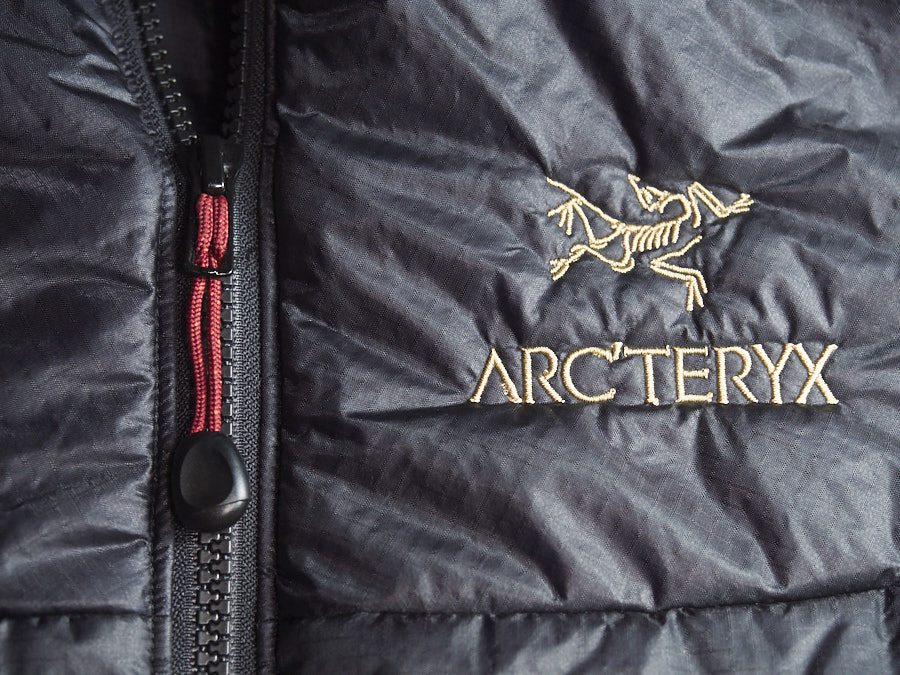
Figure 1
Front main zip, and embroidered Arc'teryx logo with wordmark. The embroidery thread is a very light yellow.
Table of Contents
- The Job to Be Done
- Construction Part 1, ThermaTek
- Construction Part 2, Materials
- Construction Part 3, Sewing
- History
- Features
- In Use
- Issues
- Grab Bag
- Conclusion
The Job to Be Done
Upon initial inspection, the Dually does not seem inviting. It is fit too big, it has no drape, the skin feel is terrible, and it isn't especially warm. But a jacket can never be all things to all people. It must give up traits to acquire other traits — it must compromise. This jacket gives up any semblance of usability in the urban setting. Wearing a Dually around town is weird looking and uncomfortable.
However, if we adventure into the cold wilderness, things change. Humans generate heat when climbing, skiing, backpacking, or doing any other aerobic activity. When they stop to have lunch, or belay, or if they get hurt, they generate much less heat. These periods of low exertion require extra insulation, and that's when you pull out your belay parka.
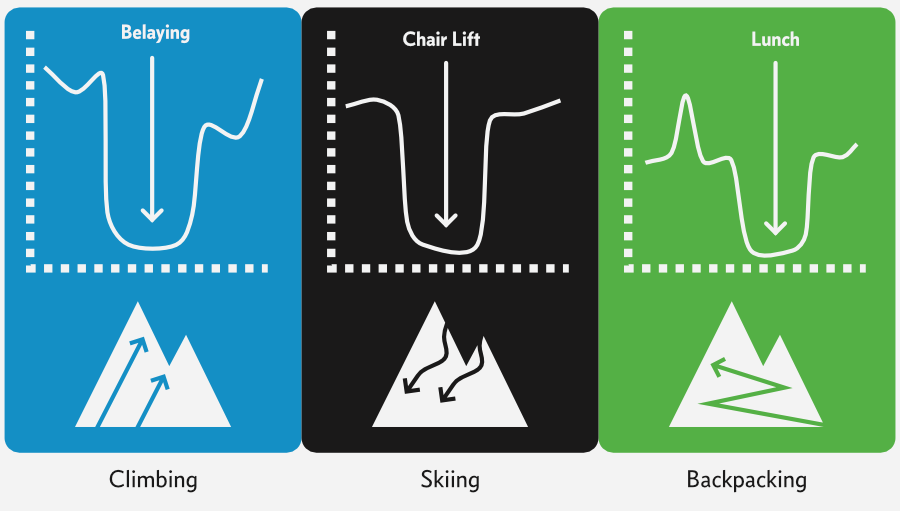
Figure 2
These charts map effort (y-axis) and time (x-axis). Each of them have a static period, indicated by the arrow and annotation. Don't let anybody fool you, lunch is extremely important. The iconography is cribbed straight from Arc'teryx' collection icons.
The "belay jacket" concept has been around for a long time, perhaps more than 30 years. Codified in many places through the decades, such as the 1999 book Extreme Alpinism. Even though they came from the world of alpinism, belay parkas are fundamentally just static insulation. Their utility is very broad across many activities. Any time you have start-stop activity in cold conditions, this type of jacket should be considered.
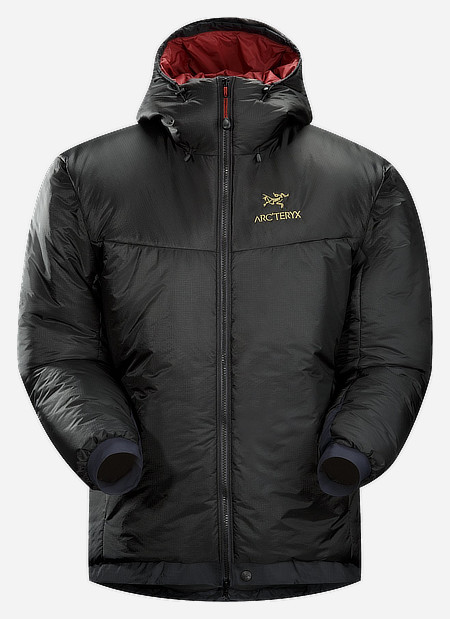
Figure 3
The Dually belay parka. Arc'teryx marketing image. I can't take a better overall product photo than this.
Construction Part 1, ThermaTek
We're going to spend a bunch of time early in this review looking at materials. The Dually is a paragon of Arc'teryx philosophy — what it is made from is just as important as how it is made.
Foundational to the Dually's design is a unique insulation technology called ThermaTek. It is a composite fabric created from two elements: sheet insulation and a nylon textile. The two are laminated together with an adhesive to create ThermaTek.
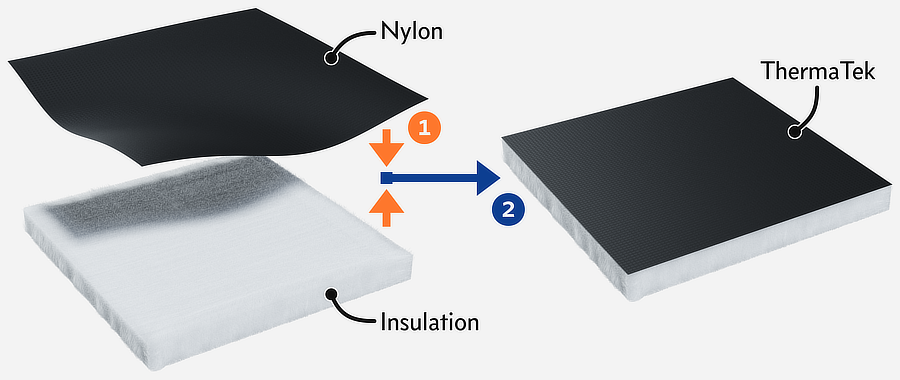
Figure 4
- The nylon and insulation are laminated together.
- The product is a composite fabric called ThermaTek.
The entire jacket, inside and out, is made of ThermaTek composite fabric. If we traverse the layers from the outside: the exterior face is black nylon. Hiding behind it is insulation, then an air gap, then more insulation. Finally, the interior liner is also black nylon.
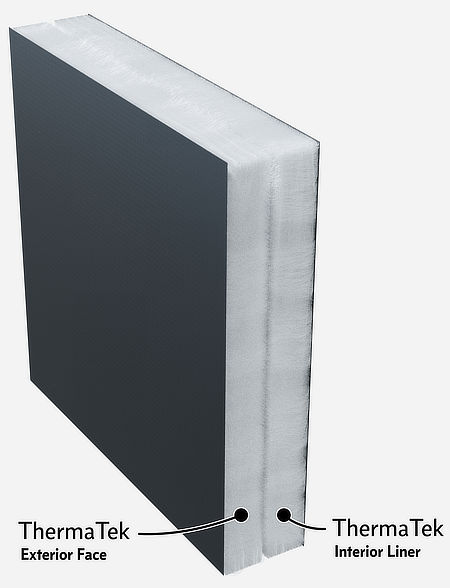
Figure 5
A visual slice of the Dually dual-layer construction, showing how both interior and exterior are the same composite fabric.
Three locations on the Dually have just one insulation layer. The hood, and underneath each arm (Figure 23). These locations use an outer layer of ThermaTek, but the interior liner is an ordinary maroon nylon textile. Most likely the hood is single layer due to the stiffness of two layers limiting articulation and adjustment. Removing one layer in the underarms reduces bulk.
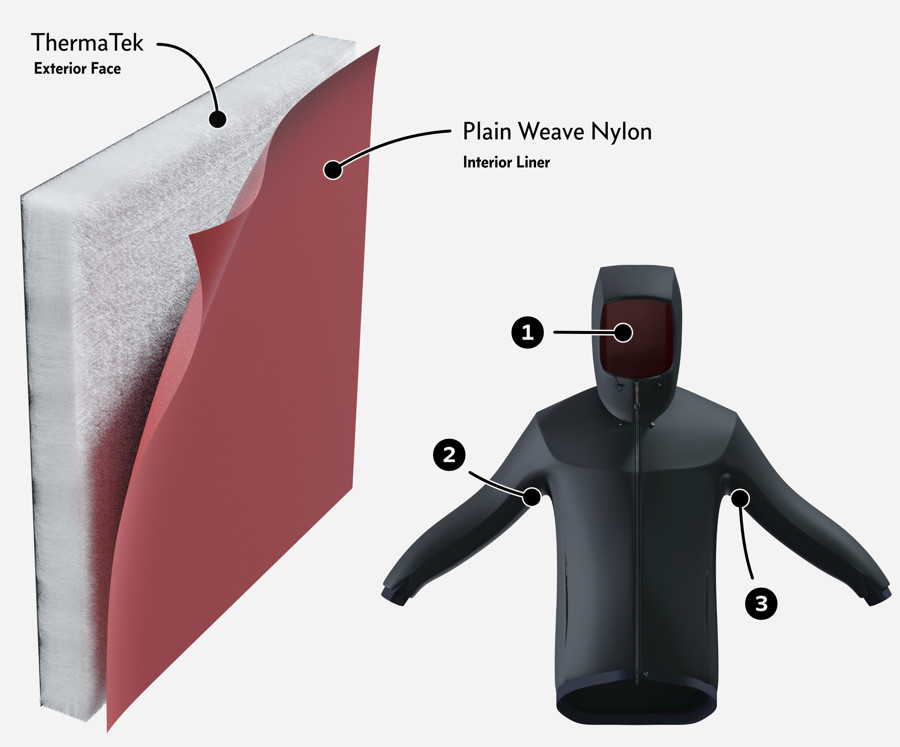
Figure 6
A visual slice of the Dually single layer area is on the left, showing the exterior ThermaTek and simple nylon liner. Single layer areas of the Dually are at 1, 2, and 3 (hood and underarms).
Construction Part 2, Materials
The black nylon is 30 denier, with ripstop threads, and impressive tenacity. It is designated N30r, and seems to be coated. The maroon textile used in single-layer locations is a plain woven nylon. It is also used inside the pockets, and to make the stuff sack (Figure 22).
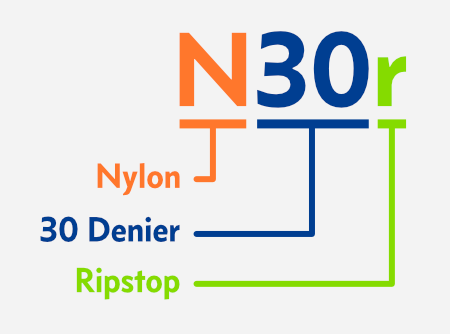
Figure 7
Breakdown of the face textile naming scheme.
ThermaTek most likely uses Climashield's Prism product for its sheet insulation. Prism is a continuous filament, 3.5 denier, hollow-core polyester insulation. The insulation is 92g/m² and is about 2cm thick. Since most of the Dually has two layers of ThermaTek, the effective insulation weight is 184g/m². Additionally, ThermaTek is treated to be extremely hydrophobic. I am not sure if this is an encapsulation process, a DWR, or both.
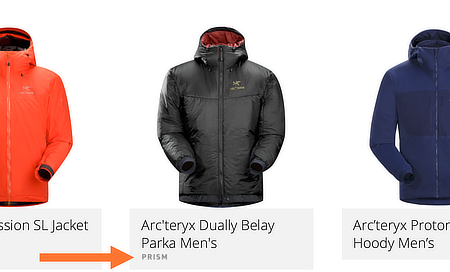
Figure 8
Screenshot of the Climashield website. The Dually is annotated with Prism (orange arrow). Other ThermaTek products have labeling consistent with this as well.
Continuous filament insulation is created by extruding an extremely long fibre from a polyester solution. The fibre can be miles long. That very long fibre is then convoluted and crimped in a proprietary process to create a uniform sheet. Like turning a ball of yarn into a tangled mess, but very carefully. The insulation sheet has high integrity, it won't shed pieces or fall apart, it doesn't require quilting to support itself.
The Dually is actively making a compromise by using a high-denier, continuous filament insulation. This type of insulation is stiffer, less soft, and less compressible than the other major type of synthetic insulation (staple). So the jacket has poor drape, is stiff, does not have that "like a cloud" softness that people expect.
However, continuous filament insulations have better loft retention, more resistance to moisture, shed less, and last longer. The benefits are clear for a more technical piece that is designed to be abused. Eschewing the decadent haptics in favour of brutal functionality is absolutely the right call here.
Construction Part 3, Sewing
The Dually is probably created in two assemblies: an external shell, and an internal liner. The two are brought together and joined along all the common edges: bottom hem, cuffs, front zip, and collar. This forms one complete jacket. Sewing the two halves of the jacket separately yields a neat interior with tucked seams. Patterning is differential, meaning the liner is designed to be smaller than the shell, and to move correctly while preserving insulation loft. There appears to be a minimum bend radius that the fabric will accept, so everything is a bit boxier than usual.
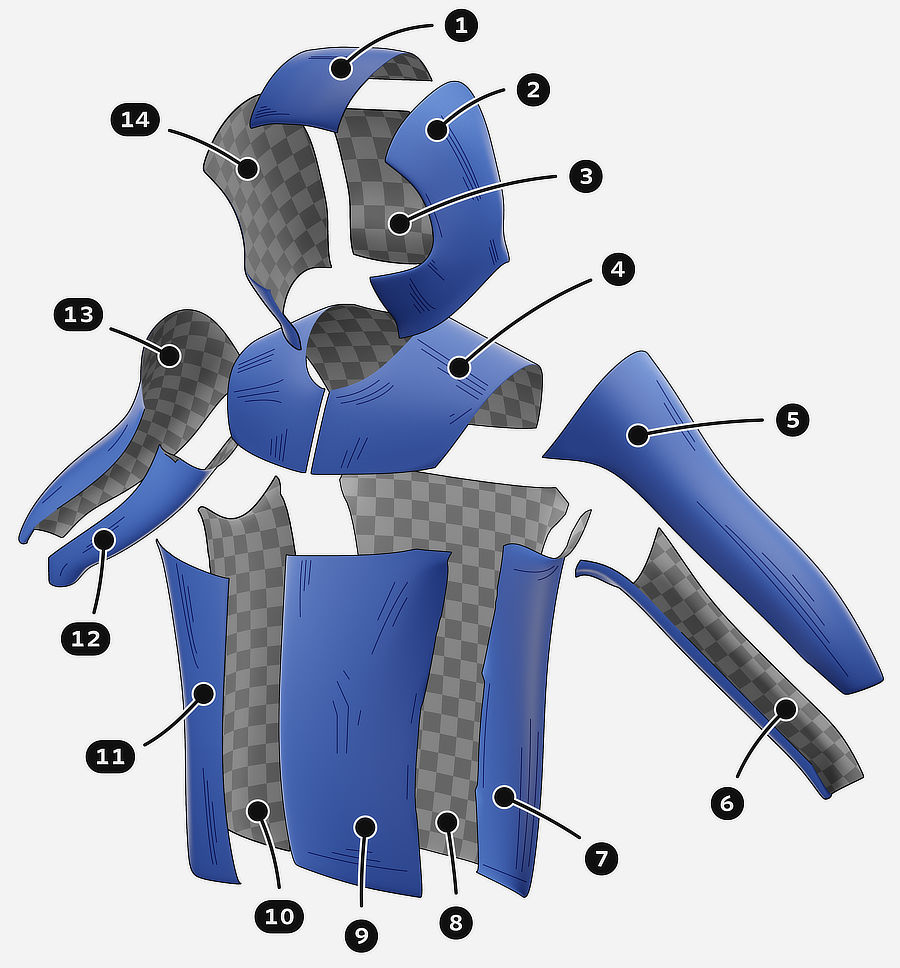
Figure 9
Exploded view of the exterior panels (14 total). Blue is the outside face, grey/checkered is the inside face.
- Hood top
- Hood left
- Hood back
- Yoke
- Sleeve front left
- Under sleeve left
- Jacket side left
- Jacket back
- Jacket front left
- Jacket side right
- Jacket front right
- Under sleeve right
- Sleeve front right
- Hood right
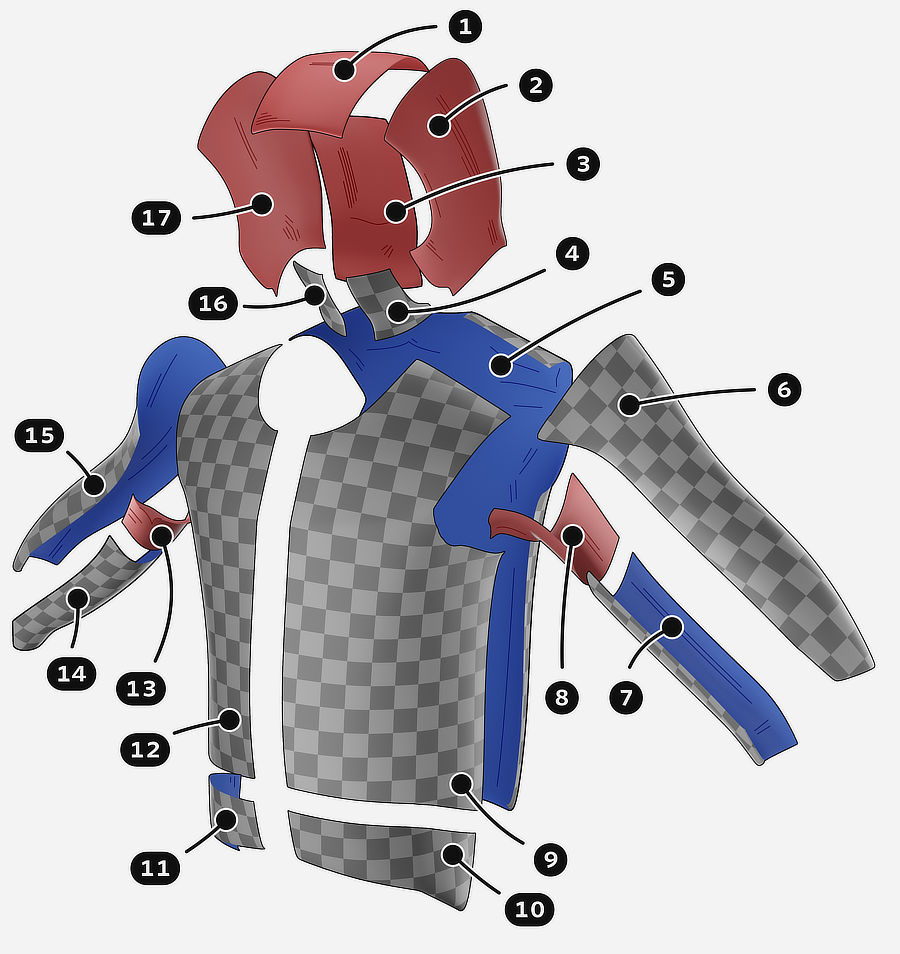
Figure 10
Exploded view of the interior panels (17 total). Blue is the inside face, red is single-layer panels.
- Hood top (one layer)
- Hood left (one layer)
- Hood back (one layer)
- Hood front left
- Back lining and yoke back
- Sleeve front left
- Lower under sleeve left
- Upper under sleeve left (one layer)
- Jacket front left and yoke front
- Lower jacket front left
- Lower jacket front right
- Jacket front right and yoke front
- Upper under sleeve right (one layer)
- Lower under sleeve right
- Sleeve front right
- Hood front right
- Hood right (one layer)
The jacket halves are also joined with an internal fabric segment at the front of the armpits. A short piece of webbing has a textile patch sewn to each end, then those patches are glued and sewn into the face and liner, linking the two sides. This construction allows some misalignment between the shell and liner, sort of like a ball joint. Letting the jacket be flexible and stuff-able, but still feel like a coherent single piece.
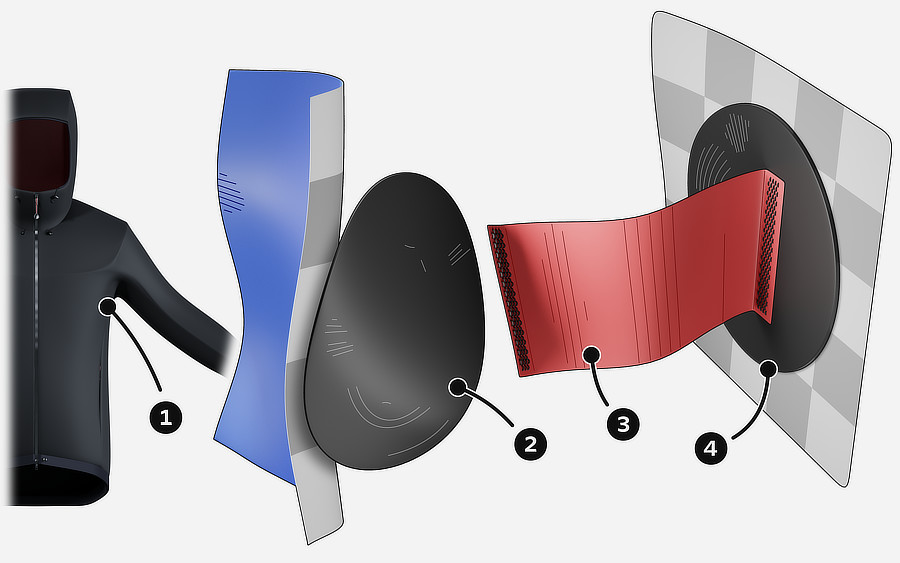
Figure 11
- There are two connectors on the jacket. At the front underarm on each side.
- A tough textile patch is sewn to both ends of a length of webbing.
- Webbing is perhaps an inch long, and provides some misalignment.
- With webbing attached one patch is sewn or glued to the face, the other patch to the liner. Connecting the jacket together.
The hood would be created as a separate piece, then joined to the jacket when the collar is sewn together. While the hood mostly uses a single-layer hung nylon liner, the front of the hood has additional pieces of ThermaTek (items 4 and 16 in Figure 10). Therefore the face is fully insulated by a two-layer area. Additionally, the hood liner isn't hung completely separately. It is sewn to the shell at the back of the hood and at the top of the hood, limiting how much it can billow.
Hand pockets penetrate through the outer layer of insulation, and sit between the layers. So there is one layer of insulation on each side of your hand. The front of the pocket has a black microfleece material, the back is another piece of maroon nylon. There is an insulated storm flap, with stiffening to avert the zipper. The hand pockets are located on the forward vertical torso seams (eg. between items 9 and 7 in Figure 9). The pocket zip sliders get pulls made of maroon cord.
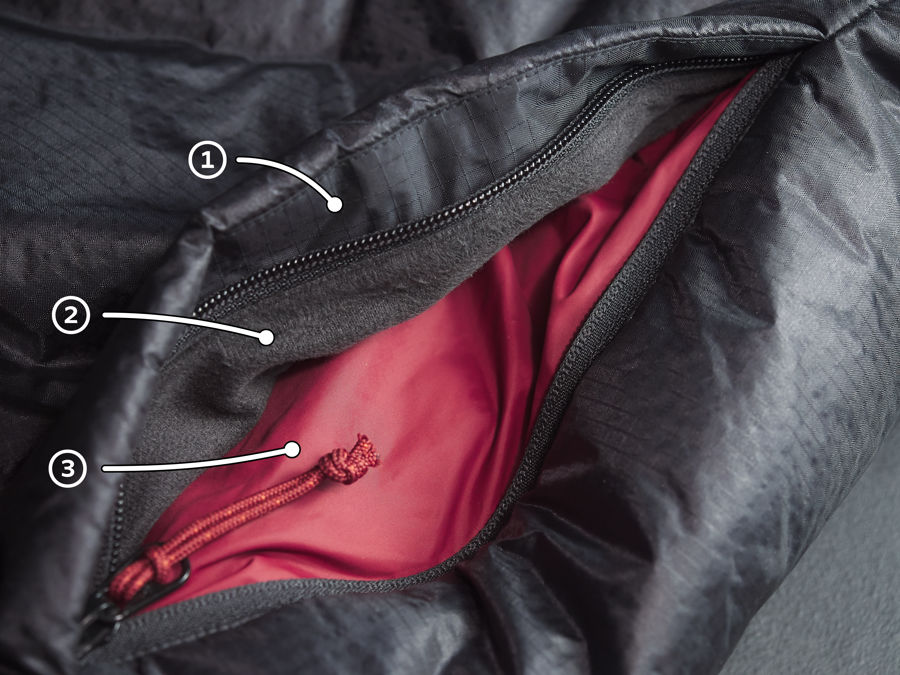
Figure 12
- Stiffened extra layer to prevent the zip from catching.
- Black microfleece liner at the front of the pocket.
- Maroon nylon liner at the back of the pocket.
Because of the differential patterning, the exterior and interior seams are offset from each other, which makes the jacket very wind resistant. There are also few seams in general, no quilting is required because the insulation is coherent and laminated. For the same reason, the insulation also can't bunch or shift, so the jacket doesn't develop cold spots.
A laudable design is used for the main zip draft tube. The liner layer of ThermaTek is extended an extra inch behind the zip. Then covered by a stiffened piece that is sewn in behind the zipper. The result is an immovable, stiff draft tube that will never impede the zip or get caught. It permanently offers a single layer of insulation behind the main zip, and blocks the wind as well. The draft tube also flares at the top for face comfort.
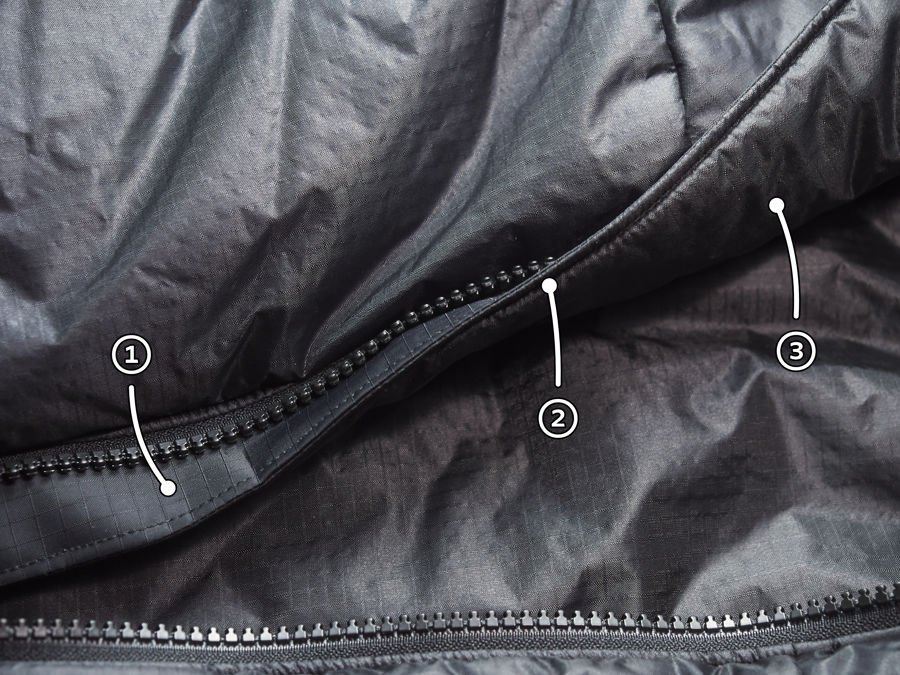
Figure 13
- Stiffened strip that is added to cover the insulation, and prevent the zipper from snagging.
- Showing that there is insulation thickness in the draft tube.
- Back side of the draft tube, it is a seamless part of the liner, there is not a separate piece sewn in.
Mobility isn't generally a focus for static insulation, after all you're supposed to be static. But you still have to be able to coil rope across your neck, reach up on the belay, or set up a tent without hindrance. Articulation is retained here by fitting the jacket oversized, using a differential pattern, rotating the armscyes forward, tapering the torso, building in underarm gusseting, and more.
There are two ways ThermaTek might be created. The first is a bulk process that favours scale manufacturing. Combining a roll of textile and a roll of sheet insulation into a roll of ThermaTek on a machine process. This would be more demanding on the sewing operator in how they manage the fabric at the station. Cutting the fabric would be harder, operators would have to trim insulation to create seams. The second possibility is that the jacket is mostly sewn together as just the nylon face. Then it is laid out, and cut sections of sheet insulation are affixed to the inside. This is better for smaller scale production, but there are more opportunities for misalignment. You have to cut twice as much fabric, and you still have to sew some seams with insulation installed. No matter how it is done, ThermaTek is difficult to work with. It requires extra set up, care, and space. These considerations would have made it hard to pattern complex shapes, or small filler panels.
History
The initial Fall 2007 version of the Dually was produced as a unisex parka (with hood), a women's and men's jacket (no hood), and a women's and men's vest. Jacket and vest versions were only available for two seasons (composite image). All models were available in Cinder (a dark grey with black accents), and Picasso Red (bright red with black accents) until Spring 2009. Starting Fall 2009, the Dually was only available in black.
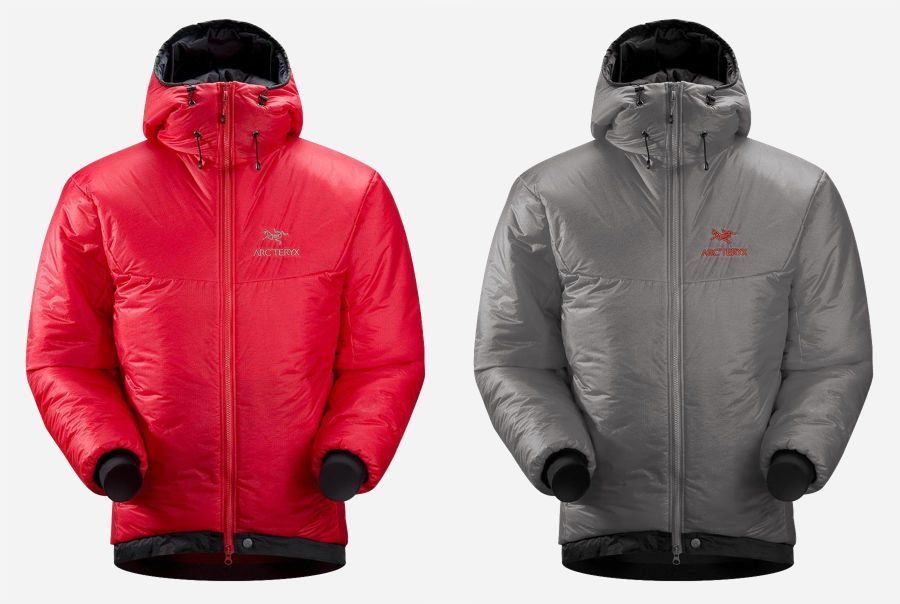
Figure 14
Arc'teryx product photos of the fall 2007 Dually Belay Parka. Left: Picasso Red (red). Right: Cinder (grey).
The Dually vanished from the lineup for Fall 2012 and Spring 2013, but returned as a revised model for Fall 2013 (shown in Figure 3). Some major changes were: a slightly larger fit (longer hem, bigger chest and shoulder diameters), a new triangular forearm gusset for the stretch-knit cuff, added the maroon textiles/accents, and removal of one layer of ThermaTek under the arms. This model continued through to the time of this writing, Fall 2020 (Update: the Dually is no longer available for Spring 2021, and appears to have been discontinued).
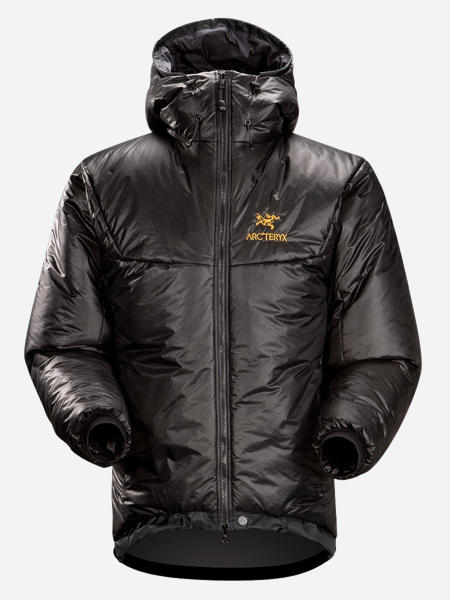
Figure 15
Arc'teryx product photo of the first generation Dually in Black colourway.
A single-layer ThermaTek companion jacket was also released for Fall 2007 in one men's style, called the Solo. It followed the same timeline for colourways, availability, and revisions, as the Dually parka (composite image). When the revised version launched in Fall 2013, the Solo added a hood. The Solo was no longer available for Fall 2015, and has been discontinued (website screenshot).
| Model | Product | First Available | Last Available | Colourways | Weight (g) |
|---|---|---|---|---|---|
| 5598 | Dually Belay Parka (Unisex) | Fall 2007 | Spring 2012 | Picasso Red, Cinder (F07 - S09) Black (F09 - S12) |
675 |
| 5597 | Dually Belay Jacket Men's | Fall 2007 | Spring 2008 | Picasso Red, Cinder | 600 |
| 5596 | Dually Belay Jacket Women's | Fall 2007 | Spring 2008 | Picasso Red, Cinder | 500 |
| 5595 | Dually Vest Men’s | Fall 2007 | Spring 2008 | Picasso Red, Cinder | 300 |
| 5594 | Dually Vest Women’s | Fall 2007 | Spring 2008 | Picasso Red, Cinder | 295 |
| 4502 | Solo Jacket Men's | Fall 2007 | Spring 2012 | Picasso Red, Cinder (F07 - S09) Black (F09 - S12) |
400 |
| 12716 | Solo Hoody Men’s | Fall 2013 | Spring 2015 | Black | 500 |
| 12717 | Dually Belay Parka Man's | Fall 2013 | Fall 2020 | Black | 700 |
Figure 16
Table of Dually and Solo models through time.
- Model is the Arc'teryx model number.
- First Available is the first season the product was available.
- Last Available is the last season the product was available.
- Colourways shows the colours the product was available in, and the season ranges for those colours.
Features
A necessary feature in belay parkas is generous drop pockets. The Dually does it right, with enormous drop pockets. Each pocket will accept a bicycle helmet, just barely. They are positioned well for easy reach, have a slightly elasticized opening for retention, and a lot of pleating for volume. They are slanted, with the back of the pocket higher than the front of the pocket, for easy access and more security. I've used them for giant mitts, coiled rope, water bottles, other jackets, and more. As a bonus the pockets are mesh, and the jacket rejects water inside just as much as outside. You can throw absolutely saturated gloves into your drop pockets and it's totally fine! There's also a small loop sewn into the rear-top of the drop pocket on the right side.
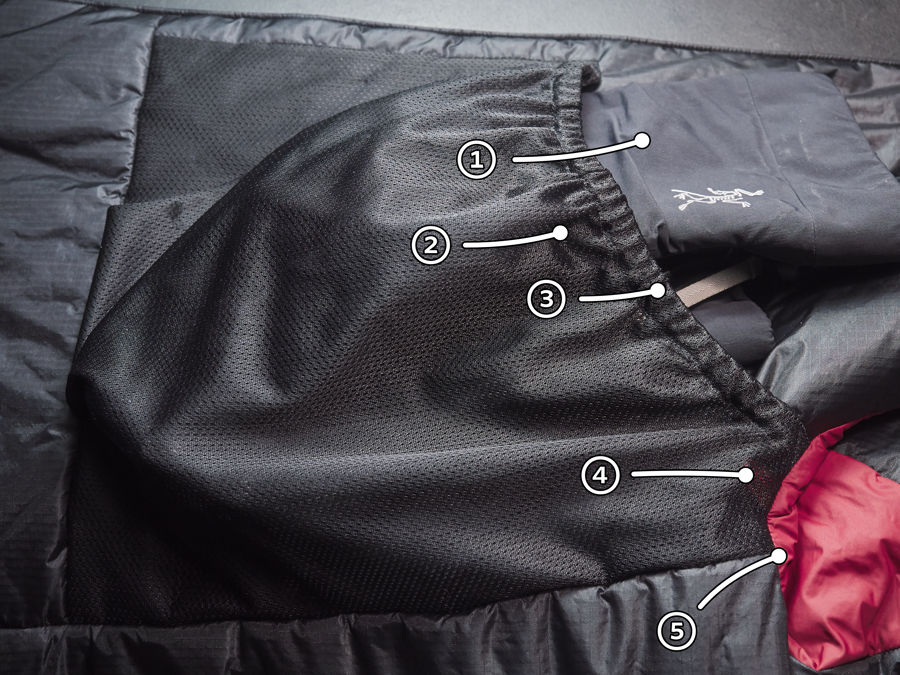
Figure 17
- Arc'teryx Beta AR gloves in pocket.
- Pleating, allowing the pocket to expand and accept large items.
- Pocket opening with elastic hem to retain items.
- Small red webbing loop sewn inside the drop pocket (only on the right side).
- Indicates how far back the pocket goes, this is the armpit seam.
Fit is kind of subjective, some people prefer looser, some prefer tighter. The correct fit for this style of jacket is absolutely on the loose side. Appropriately, the Dually fits almost a full size larger than most Arc'teryx garments. Men: buy your regular letter size, unless you're between sizes. The jacket will be quite big, and that's good. Women: buy a size down for sure, and maybe two sizes down depending (unfortunately, an XS is not available). The Dually is built in the men's fit block only. The shoulders and chest are very large, the torso tapers down significantly, and the arms are quite long.
The back of the collar has a low profile, stretch-knit, gasket. About 4cm at its widest part. This mostly prevents rain, snow, and wind from going down your back. Many parkas have a large, plush draft collar which I usually like. But this gasket has never gotten in the way, been a hassle, or caused me to feel cold.
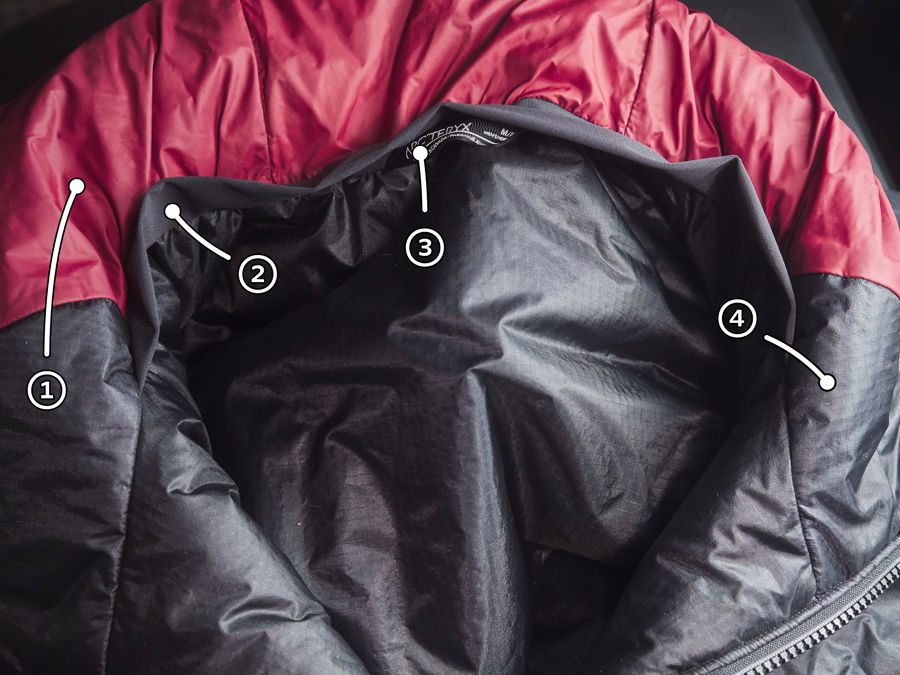
Figure 18
- Interior liner of the hood.
- Stretch-knit neck gasket.
- Country of origin tag and hang loop.
- Second layer of ThermaTek inside the front of the hood.
This hood is certainly designed to accommodate a helmet. It is large and square, and it will swallow almost anything. The top edge has a small stiffened brim piece. There is a drawcord at the rear base of the neck which adjusts hood volume and cant. There is also a drawcord running through the leading edge of the hood, within a nylon channel. All of the drawcords use traditional cord locks. The front drawcords feed through the hood front and exit at the clavicle. None of the hood adjustments are super effective, but they do let you tune a bit. ThermaTek is just very stiff, and it's hard to apply enough tension with elastic cords and cord locks to reshape the hood dramatically. Overall I would say the hood is adequate.
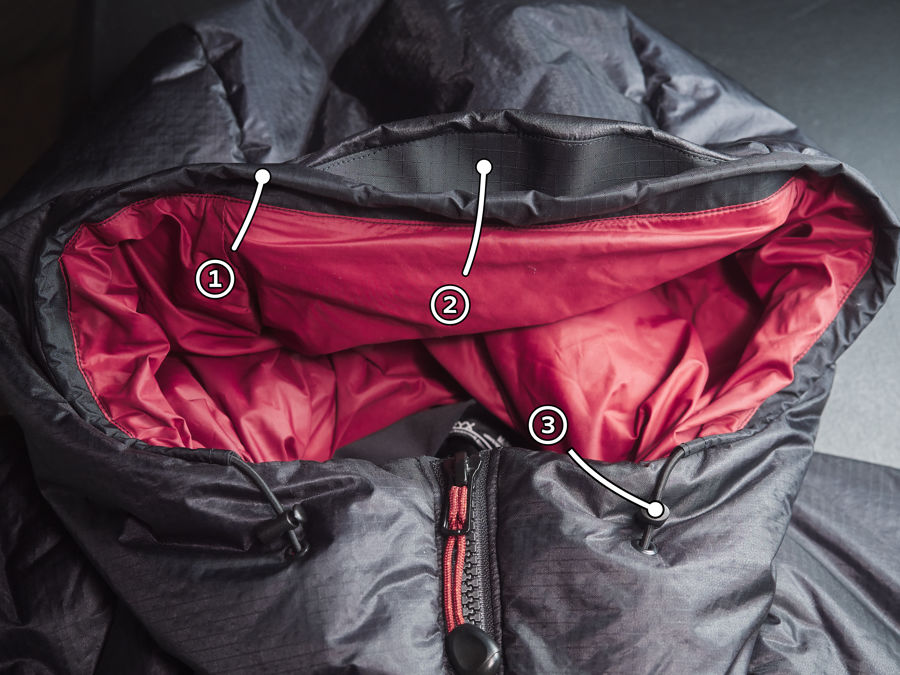
Figure 19
- Nylon runner that surrounds the opening of the hood, it carries a drawstring for adjusting the hood.
- Small stiffened hood brim.
- Cord lock that closes up the face opening, one on each side.
The jacket front is cut quite short, with a centre front length of 61cm. This is a trend with Arc'teryx climbing garments: a short front for mobility. That design doesn't seem necessary on a parka since mobility isn't a primary concern. However, I have no complaints. It is long enough to keep me warm, and it gets out of the way. This means the side hem angle from front to back is steep because the rear is very long: 84cm centre back length. The drop tail hem gives your butt plenty of coverage, and is absolutely awesome. Both of these length measurements taken from the collar seam to the hem end, jacket size medium.
Stretch-knit cuffs are used, complete with a fairly deep triangular gusset up the forearm. This allows limited stretch to fit the cuff over gloves. They are simple and reliable cuffs which do not take on much water, and do not freeze up.
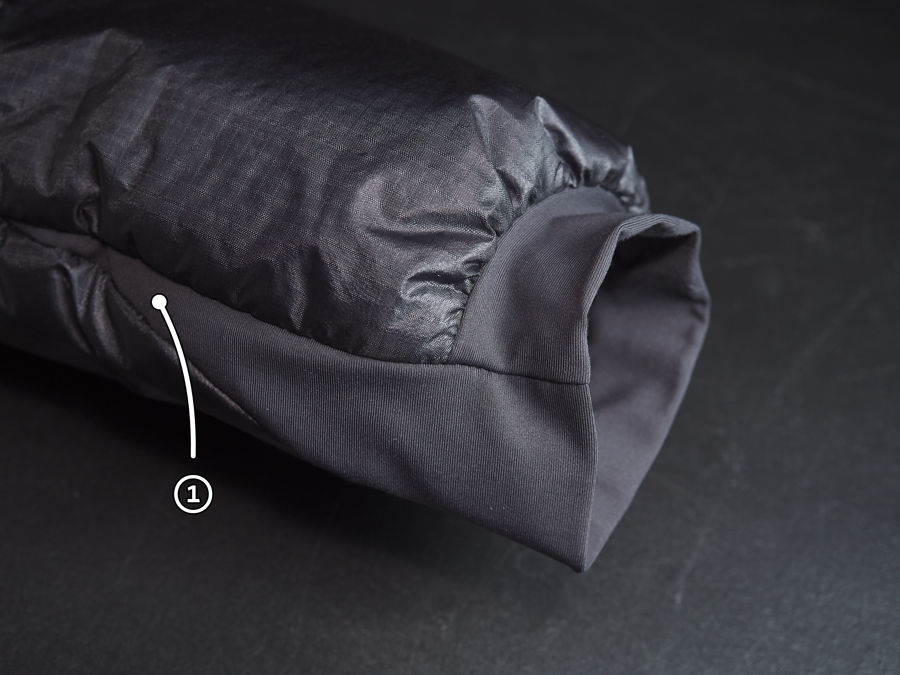
Figure 20
- Triangular cuff gusset, which extends up the forearm.
As expected on a belay parka, the main zip is a double zip. While double zips can be difficult to start, this one is beyond reproach. Even with mitts and gloves on I've never had a problem. There is no material in the way, nothing for it to get caught on, and the slider pull is large. The zipper is a YKK Vislon #5.
There is a drawcord within the bottom hem, and a cord lock on each side. The Dually has no waist cord. Also integrated into the bottom hem is a metal snap closure. This lets you zip the two-way zipper up at the bottom, snap the hem together, and belay while preventing the parka from billowing. The hem itself is a tough nylon, and it is not insulated.
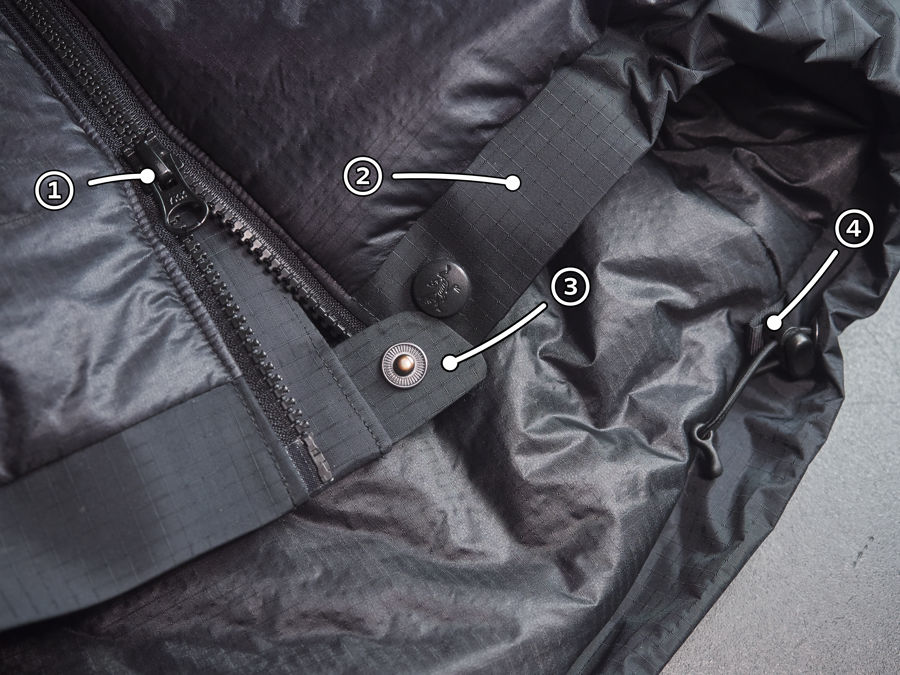
Figure 21
- Second slider on the main zip.
- Bottom hem. Doubles as a nylon runner for the hem drawstring.
- Hem tab containing one side of the snap. The other side of the snap is embossed with the Arc'teryx logo.
- Hem cord lock, there is one on each side. The cord loop that comes through has a plastic tab on it. This cord lock passes the cord through twice and has strong engagement.
A stuff sack is supplied, made from the same maroon plain weave that is used on the jacket. It has a white webbing hang loop, and a drawcord closure with cord lock. The sack is sufficiently large, stuffing isn't too difficult. However, those who like a generous stuff sack will still want to bring their own.
In Use
Everything I threw at it was no problem: snow, rain, wind, and cold. It fits over everything, holds water bottles in the drop pockets, and thaws my hands. It even keeps you pretty warm in compressed areas, such as under pack straps. The zips work with gloves, it doesn't get destroyed by racked climbing gear, and the hem seals up nicely.
In my experience the Dually is warm to around -8°C ambient, over a 200g/m² wool base layer, with light wind, completely static. That doesn't sound like much, but it is designed to scale with active insulation. In practice I have worn it down to -25°C ambient before getting chilly. At -15°C I'm usually adding a fleece and a wind shell to my active kit, then the Dually goes over top. As it gets colder, I add warmer active layers, and that gives the Dually extra warmth to keep going lower.
Dry cold is relatively easy for parkas to deal with. However, rain is a big challenge for insulation of all types. Down insulation is notorious for clumping and becoming useless when wet. Synthetic insulation structures can also saturate and lose efficiency. I have worn the Dually over a fleece, in a continuous downpour, for six hours straight. Water never got through, it's practically a shell. In that time it still took on almost no water, and dried out fully in about 30 minutes despite the humidity and cold. I've put it on over a soaked shell, then packed it away wet, and it didn't care. The DWR is robust, but not necessary for the jacket to reject water. The Dually is the most comprehensive answer to ugly damp cold that I have ever encountered.
Product care is a big focus for me, and I can report that it is easy in this case. Washing machine or hand wash, no problem. It dries quickly in the dryer, and air dries quickly too. Product storage off-season is easy: just wash and dry, drop it loosely into a big pillow case, close up the top, and toss it into the closet.
It is not particularly easy to stuff into its sack when new, mostly due to the stiffness of the textile. It breaks in a bit over time and gets easier to stuff. In my view there isn't a lot of reason to use the sack most of the time. Stuff it into your pack and go. Or sling it over the top under the pack lid like a rope. Because the exterior and interior of the jacket are the same tough textile, you can just toss it around and not care, which is liberating.
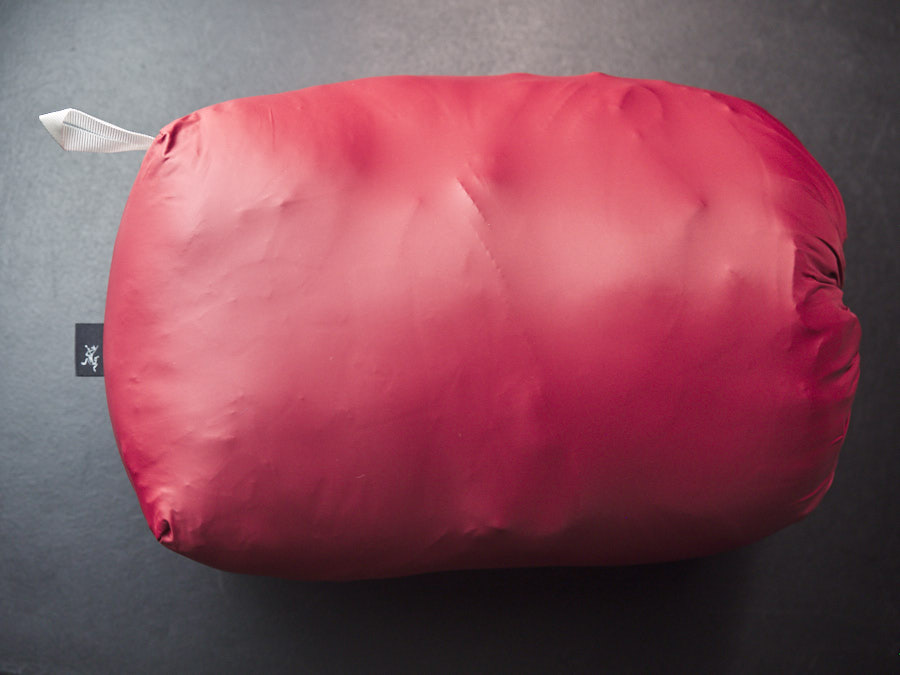
Figure 22
The Dually stuffed into its sack. There is a white hang loop sewn in, and an Arc'teryx logo tab. On the right, just out of view, is the opening drawstring with cord lock.
There has always been competition between synthetic and down parkas. Down certainly packs smaller, is lighter, and has better long term loft retention. Unfortunately, down's warmth is influenced by humidity, and slowly degrades over consecutive days of use. Down acquires cold spots as the loose insulation shifts around, and if you tear a baffle the insulation spills out. The Dually has none of those problems. No cold spots, no change in warmth no matter how wet, no insulation spills. In the real world stuff gets damp, it gets damaged, it gets slept and sweated in. At very cold temperatures (colder than -25°C) I still often prefer down. But for everything warmer I always take the Dually because it is dependable.
Issues
Keeping fully in mind that this is a climbing parka, and is designed to be used with a helmet. The parka is also very useful in many other circumstances. The hood is kind of awkward and weird for applications without helmets. It would be neat to be able to adjust the hood a bit more optimally for use without a helmet. In addition, the nylon hood liner can stick to your wet helmet, or wet inner hood. It is a little awkward and annoying to peel your hood off of your helmet. A different liner textile might be better.
I have quibbles about the hand pockets. First of all, they are sort of shallow. Having luxurious hand pockets, with room for hands plus stuff, is great. These are just a touch shorter than you'd really want. The fleecy front pocket liner saturates with water and can get cold. Which is notable because most of the rest of the jacket refuses to hold water. The nylon pocket liner sticks to wet surfaces and wet skin. This is annoying when you're trying to stuff damp hands or damp objects into your pockets in a hurry. Ideally the pocket liners would use a low-friction textile that doesn't hold water.
In the past ThermaTek has come in a few colours. Unfortunately, for a long time now it has only been available in black. This is probably for logistics and cost reasons, but it remains a shame. Being able to get your trusty parka in bright red, bright yellow, or blaze orange is highly preferable for safety reasons. It's also more cheery!
The triangular gusset on the inside of the cuffs improves their ability to stretch over big gloves. However, I still think the cuffs are probably a bit tight. It would be convenient if they were stretchier, or slightly larger.
Grab Bag
The Dually is manufactured in Canada, at the ARC’One factory in Vancouver. If the insulation is indeed based on a Climashield product, that insulation is manufactured in Clinton, Tennessee. Making the Dually largely a product of North America.
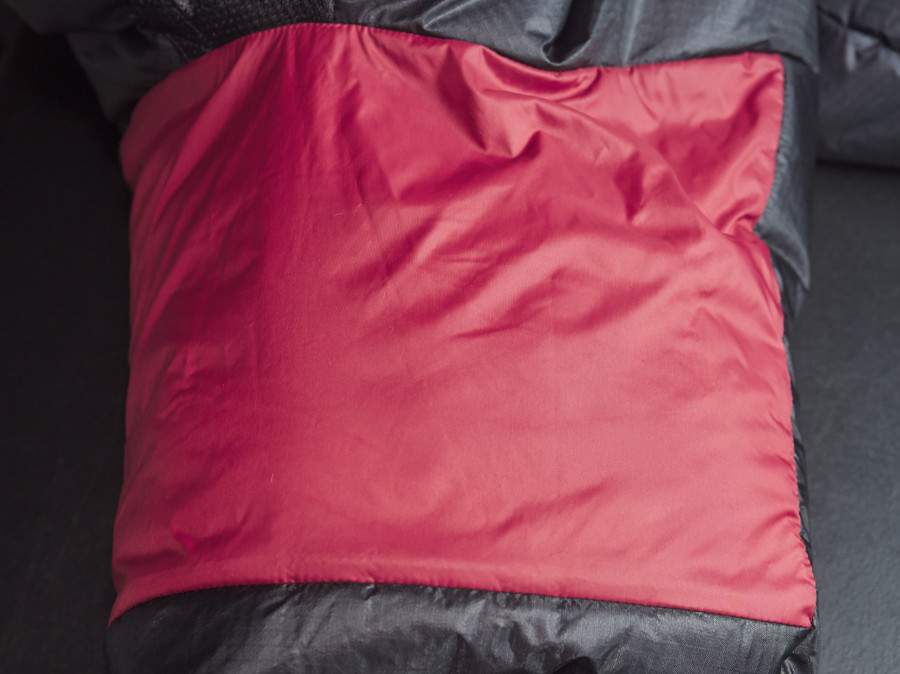
Figure 23
The single-layer, interior underarm panel. Item 8 in Figure 10.
It is speculated that the name of the jacket reflects its insulation design. Both the Solo and the Dually are adverbs for their respective quantities. The Solo had a single layer of ThermaTek (solo = single). The Dually has two layers (dually = dual).
The Dually is fit very loose, which is perfect for its intended use case. But the fit designation on the Arc'teryx website has varied over the years. It has been called Athletic fit, Expedition (XPD) fit, and Regular fit. The hang tag as of Fall 2019 lists an Expedition fit, which definitely seems correct.
In size Medium, on my scale, the Dually weighs 723g and the stuff sack weighs 16g. For a combined weight of 739g (versus 705g official weight, 4.8% overweight). For stuffed volume, the size Medium in its stuff sack has a 200mm diameter and is 280mm tall (approximately), for around 9L. In practice the volume is a bit smaller because the top and bottom are curved, the diameter isn't consistent, and it's squishy.
Here are scans of some of the hang tag booklet pages: Product Details page and ThermaTek page. And a scan of the new all-black, embossed, hang tag booklet cover without collection text.
It does have a hang loop at the collar (item 3 in figure 18), which can be convenient for air drying. Instructions on the care tag indicate machine wash gentle/delicate setting with cold water, and tumble dry low. Do not bleach, do not iron, do not dry clean. Also, a picture of the contents page and the model details page of the care tag booklet.
Conclusion
Philosophically, the Dually is a manifestation of the Arc'teryx north star. It is the kind of product that defined the brand. The kind of kit that Arc'teryx must build if they want to be taken seriously. Resolutely technical, tremendously focused, and best-in-class. We need more like this.
The Dually is a simple design that is elevated by materials, attention to detail, and quality. It has only the features you need, and none you don't. If you have use for a mid-weight technical parka, I recommend it with no equivocation. It is sublime.
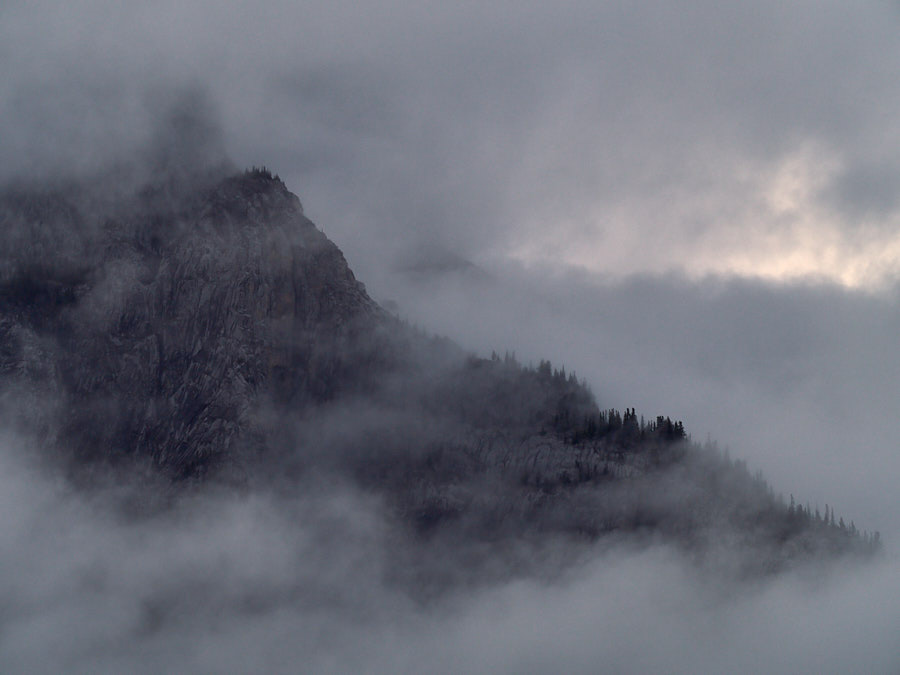
Figure 24
See you out there.